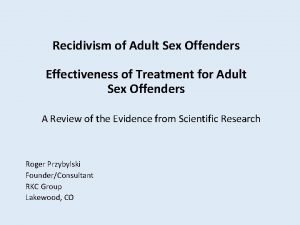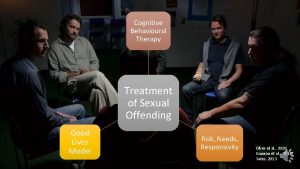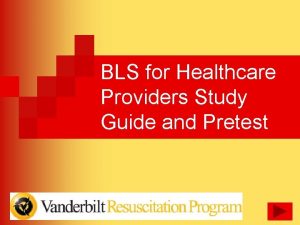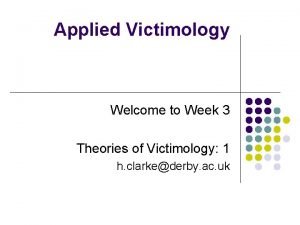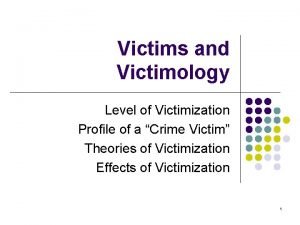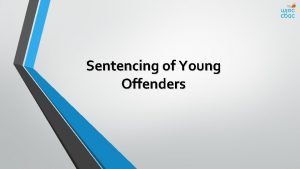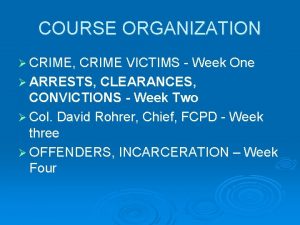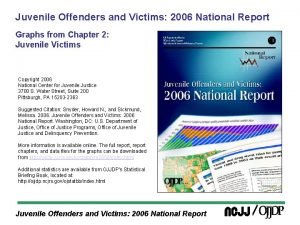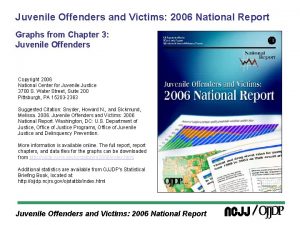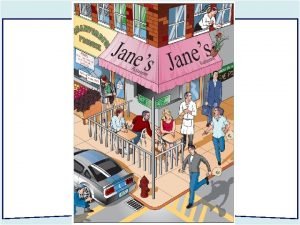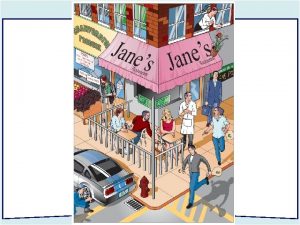Chapter 3 The Crime Picture Offenders and Victims






























- Slides: 30

Chapter 3 The Crime Picture: Offenders and Victims © 2015 Cengage Learning

Learning Objective 1 • Discuss the primary goals of civil law and criminal law and explain how these goals are realized. Ricky Carioti/The Washington Post via Getty Images © 2017 Cengage Learning. All rights reserved.

Classifications of Crime • Civil law – Civil court is concerned with responsibility. – The burden of proof is the preponderance of the evidence. – The remedy for violations of civil law is compensation. © 2017 Cengage Learning. All rights reserved. • Criminal law – Criminal court is concerned with guilt. – The burden of proof is beyond a reasonable doubt. – The remedy for violations is some form of punishment.

Classifications of Crime • Felonies – More serious than misdemeanors – Punishable by death or imprisonment in a penitentiary for a period of a year or longer © 2017 Cengage Learning. All rights reserved. • Misdemeanors – Less serious crimes – Punishable by a fine and/or incarceration in a local jail for up to one year

Classifications of Crime © 2017 Cengage Learning. All rights reserved.

Learning Objective 2 • Explain the differences between crimes mala in se and mala prohibita. © 2017 Cengage Learning. All rights reserved.

Classifications of Crime • Mala in se – Acts that are inherently wrong, regardless of whether they are prohibited by law – Examples include murder, rape, and theft © 2017 Cengage Learning. All rights reserved. • Mala prohibita – Acts that are made illegal by criminal statute and are not necessarily wrong in and of themselves – Examples include speeding and loitering

Discussion Questions Drugs: To Legalize or Not? • Provide reasons why marijuana should be legalized. • What other drugs should be legalized, or not legalized, and why? • What role should the federal government play regarding drug use? © 2017 Cengage Learning. All rights reserved.

Learning Objective 3 • Identify the publication in which the FBI reports crime data and list the two main ways in which the data are reported. © 2017 Cengage Learning. All rights reserved.

Measuring Crime in the U. S. • The Uniform Crime Report (UCR) – Produced by the Federal Bureau of Investigation • The UCR includes data collected from 18, 400 policing agencies each year, including: – Number of arrests – Number of crimes reported – Number of police employees © 2017 Cengage Learning. All rights reserved.

Measuring Crime in the U. S. • Part I Offenses: – Violent crimes – Property crimes • Part II Offenses: – Includes all crimes that do not fall into the category of Part I offenses – Measured only by arrest data © 2017 Cengage Learning. All rights reserved.

Measuring Crime in the U. S. • Problems with UCR – Police notification – Discretion – Definition © 2017 Cengage Learning. All rights reserved.

Measuring Crime in the U. S. © 2017 Cengage Learning. All rights reserved.

Measuring Crime in the U. S. • The National Incident-Based Reporting System – Expanded the UCR – Collects data on each single crime within 23 offense categories of 49 specific crimes – Four data sets: • • Offenses Victims Offenders Arrestees © 2017 Cengage Learning. All rights reserved.

Learning Objective 4 • Distinguish between the National Crime Victimization Survey (NCVS) and self-reported surveys. © 2017 Cengage Learning. All rights reserved.

Measuring Crime in the U. S. © 2017 Cengage Learning. All rights reserved.

Victims of Crime • Victim surveys are a method of gathering information in which citizens are surveyed directly regarding their criminal victimizations. – Victim surveys attempt to uncover the dark figure of crime. • National Crime Victimization Survey – Advantages in comparison to UCR • Self-report surveys ask respondents to tell about their criminal activities. – Self-report surveys are also an attempt to measure the dark figure of crime. © 2017 Cengage Learning. All rights reserved.

Victims of Crime © 2017 Cengage Learning. All rights reserved.

Learning Objective 5 • Describe three ways that victim’s rights legislation increases the ability of crime victims to participate in the criminal justice system. AP Images/The News-Herald, Duncan Scott, Pool © 2017 Cengage Learning. All rights reserved.

Victims of Crime • Crime Victims’ Rights Act of 2004 – Victims’ right to participate in the system • The right to be informed • The right to be present • The right to be heard • Enforceability of legislation • Victim services © 2017 Cengage Learning. All rights reserved.

Learning Objective 6 • Discuss one major concern regarding victim participation in the criminal justice process. © 2017 Cengage Learning. All rights reserved.

Victims of Crime • The risks of victimization • Routine activities theory – Likely offender – Suitable target – Absence of capable guardian • Repeat victimization • Victim-offender connection © 2017 Cengage Learning. All rights reserved.

Learning Objective 7 • Identify the three factors most often used by criminologists to explain changes in the nation’s crime rate. Source: Federal Bureau of Investigation. © 2017 Cengage Learning. All rights reserved.

Crime Trends in the U. S. • The “usual suspects” of crime fluctuation – Imprisonment – Youth populations – The economy • Continuing decreases © 2017 Cengage Learning. All rights reserved.

Crime Trends in the U. S. © 2017 Cengage Learning. All rights reserved.

Learning Objective 8 • Explain why income level appears to be more important than race or ethnicity when it comes to crime trends. Photo by Robert Nickelsberg/Getty Images © 2017 Cengage Learning. All rights reserved.

Crime Trends in the U. S. • Crime, race, and poverty – Official crime data indicate strong correlation between minority status and crime – Neighborhoods with higher levels of disadvantaged individuals have higher violent crime rates – Lack of education, a handicap faced by low-income citizens, seems to correlate with criminal activity – There is often a distinct lack of data regarding ethnicity and offending © 2017 Cengage Learning. All rights reserved.

Learning Objective 9 • Discuss the prevailing explanation for the rising number of women incarcerated in the United States. © 2017 Cengage Learning. All rights reserved.

Crime Trends in the U. S. • Women and crime: – Crime is a predominantly male activity; however female offending rates are steadily increasing. – Criminal justice system is now more willing to incarcerate women. • Women as crime victims – Common crimes against women: someone known to victim; domestic violence – Increased exposure in the workplace © 2017 Cengage Learning. All rights reserved.

Crime Trends in the U. S. • Mental illness and crime – Risk factors for violent crime • Gun control • Drug abuse – Risk factors for victimization • Poverty because of inability to find and keep job • Homelessness • Inability to make prudent decisions in dangerous situations © 2017 Cengage Learning. All rights reserved.
 A custodial institution for young offenders.
A custodial institution for young offenders. Cognitive behavioral therapy for sex offenders
Cognitive behavioral therapy for sex offenders Juvenile delinquents act
Juvenile delinquents act Cognitive behavioral therapy for sex offenders
Cognitive behavioral therapy for sex offenders According to choice theorists, offenders:
According to choice theorists, offenders: Juvenile delinquency graphic organizer
Juvenile delinquency graphic organizer Youthful offenders act 1854
Youthful offenders act 1854 Wm3 autopsy photos
Wm3 autopsy photos Rhonda scheffler
Rhonda scheffler Joe tinning tami lynne tinning
Joe tinning tami lynne tinning Canadian centre for victims of torture
Canadian centre for victims of torture Unit 2 fashion victims answers
Unit 2 fashion victims answers Contribution of hans von hentig in victimology
Contribution of hans von hentig in victimology Explain two contrasting understandings of salah.
Explain two contrasting understandings of salah. Pack strap carry definition
Pack strap carry definition After positioning yourself directly above the victims head
After positioning yourself directly above the victims head Religious beliefs about helping victims of war
Religious beliefs about helping victims of war Victims
Victims Evelyn miroth
Evelyn miroth Ideas have consequences bad ideas have victims
Ideas have consequences bad ideas have victims Hyatt regency walkway collapse photos
Hyatt regency walkway collapse photos 3 tiers of support for second victim
3 tiers of support for second victim Mendelsohn's theory of victimization
Mendelsohn's theory of victimization Victimology in criminology
Victimology in criminology Thourghout
Thourghout Characteristics of the victims of muti murders
Characteristics of the victims of muti murders Psychological types of victims
Psychological types of victims Axel johanson
Axel johanson Shadows of hiroshima
Shadows of hiroshima Gettler test in drowning
Gettler test in drowning Michigan murders
Michigan murders

